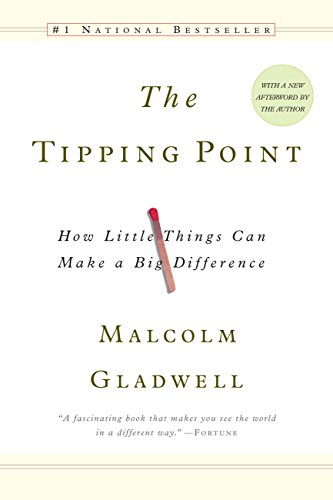

This article is an excerpt from the Shortform summary of "The Tipping Point" by Malcolm Gladwell. Shortform has the world's best summaries of books you should be reading.
Like this article? Sign up for a free trial here .
What is the “Power of Context”? Where does it come from? Why is it important in business, sales, and marketing?
The Power of Context is the idea that the environment in which the message or idea is delivered can have a huge impact on whether enough people adopt and spread it to create an epidemic. This idea was popularized in Malcolm Gladwell’s book The Tipping Point.
We’ll cover examples of the power of context and look at why the context of a message can make all the difference.
The Power of Context
There are three factors that can be adjusted to turn an idea into a social epidemic: the messenger (the law of the few), the message itself (the stickiness factor), or the context of the message (the power of context).
The Power of Context: The environment in which the message or idea is delivered can have a huge impact on whether enough people adopt and spread it to create an epidemic.
Change How the Message is Received (The Power of Context)
Human behavior is greatly affected by the context of our environments. The Power of Context capitalizes on this insight and suggests altering the context in which people receive your message or idea can make them more receptive to it. This is a little abstract, so let’s take a look at some examples.
On a small scale, you probably behave differently whether you’re with your family, your coworkers, or your old college friends. You’re also likely to act differently in public than you do in the privacy of your home. Is this effect powerful enough to determine whether you follow a fashion trend or join a social movement?
We often don’t realize how profoundly the environment alters how we act. Context changes subconsciously cue us to behave differently — sometimes drastically so — or force us into a new routine that has ripple effects on our actions.
- (Shortform example: Say you take the same route to work every day. One day, the bridge you cross is closed for a construction project that will last three months. You are forced to take another route. This, in and of itself, is a change in behavior. But perhaps this new route is also 15 minutes longer, so you have to set your alarm earlier, or shorten your morning workout, or miss your favorite morning news segment because it comes on at 7:20 and now you have to be out of the house at 7:15. A small change can have many downstream ripple effects.)
Even subtle changes can have a significant effect on how we act. This is the Power of Context. In 1964, a woman named Kitty Genovese was stabbed and killed on a NYC street, despite the fact that there were 38 people witnessinges to the attack. At the time, most reports of the incident blamed witnesses’ inaction on urban callousness. Psychologists later attributed this to the “bystander effect,” which says that when people are in a group, they are less likely to act because they either assume someone else will or assume the problem is less serious because other people are not acting. Genovese, then, would have had a better chance of getting help if she’d been attacked in a more discreet location with just one witness. However, most reports of the incident blamed witnesses’ inaction on urban callousness.
Social and Environmental Context Alters Our Behavior
Whereas the first two principles of epidemics address the people who help spread the message far and wide (The Law of the Few) and how effectively an idea or message can take hold (The Stickiness Factor), the third principle has to do with the conditions that lend themselves to an epidemic catching on. According to the Power of Context, people are so sensitive to conditions and changes in our environment that context can determine whether or not an epidemic tips.
In the case of Paul Revere, the fact that he made his ride in the middle of the night was pivotal in helping the word-of-mouth epidemic catch on. First, it was easier to reach people knowing they were all at home in bed — rather than scattered around at work or running errands. Second, people understood that if Revere’s message was urgent enough that he had to wake them in the middle of the night, it must be important.
Subtle, seemingly insignificant changes in our immediate environments can make us more likely to change our behavior; when done on a broad enough scale, this can ignite an epidemic. This is the Power of Context. These changes may be in our physical environment or social context (think of the murder of Kitty Genovese where bystanders stood watching).
The Power of Social Context
We tend to think of ourselves as products of nature and nurture, meaning the greatest influences on who we are and how we behave are our genetics and our upbringings. However, context is so powerful that certain situations can eclipse our natural dispositions. This exemplifies the Power of Context.
The Fundamental Attribution Error is a psychological term for humans’ tendency to overestimate the importance of fundamental personality traits in explaining people’s behaviors, and underestimate the role of context. In other words, when we see someone behave a certain way, we’re more likely to assume it’s a fundamental personality trait, rather than the influence of temporary context.
For example, two comparably skilled basketball players are shooting baskets, but one is in a well-lit gym and one is in a dimly lit gym. The player in the well-lit gym obviously makes more baskets. But when spectators are asked to judge which of the two is more skilled, they choose the player in the well-lit gym, disregarding the conditions (better lighting) that greatly contributed to his success.
We make this error because human brains evolved in a way that makes us very good at processing certain kinds of information — and bad at processing others. The Fundamental Attribution Error makes the world simpler and easier to understand than considering all the variables of context, but it creates a blind spot in our understanding of all kinds of actions and events, from cheating to committing crime. This demonstrates the principle of the Power of Context.
Although it’s humbling to admit that we are so inept at judging the causes of most situations, the Power of Context is actually promising: Problematic behavior is not the inevitable actions of inherently bad people, but instead is the result of context and circumstances that can be changed and adjusted for a better outcome. Your character is not a fixed set of inherent traits — as the Fundamental Attribution Error would have us believe — but a collection of habits and tendencies that are subject to change under different conditions and context; many of us appear to have consistent character traits only because we are good at controlling our environments.
Power of Context Case Study: What Makes Children Cheat?
One example of the power of social context is a 1920s study to measure the honesty among children. Students were given various tests in different situations that made it harder or easier to either cheat or inflate their scores.
There were some unsurprising findings: older children cheat more than younger children, students from stable homes cheat a little less than those from unstable homes, and girls cheat about as much as boys.
However, there were some surprising inconsistencies.
- A child might cheat on one test but not on another, or cheat at school but not at home.
- If one group of kids took the same test under the same conditions six months apart, the same children would cheat in the same ways. But if the context was altered by changing the test material (e.g. the subject was different or an answer key was provided) or the rules (e.g. administrators imposed a time limit), the rates of cheating would change as well.
This revealed that a trait like honesty is not fundamental, but rather largely influenced by context.
The Power of (Small) Groups
The principle of the Power of Context applies not only to our physical environment and the circumstances of a situation, but also to who’s around us. Specifically, people behave differently when they’re in a group than when they’re alone. When we’re alone we’re more likely to act independently, but around other people our behavior is affected by peer pressure, social norms, and other influences; those influences can be enough to tip an epidemic.
Small groups, in particular, have a strong power to amplify a message or idea and help create an epidemic for a few reasons.
- The power of group influence is stronger when each member of the group knows her fellow group members (e.g. you care more about what your friends and family think of you than strangers’ opinions).
- Humans have a mental and emotional limit to the number of social relationships they can maintain, so the size of these groups must be within that limit in order to have that relational level of social influence.
- People rely on each other for division of labor and division of knowledge in order to work more efficiently in groups. This creates a network of interconnectedness and influence.
Power of Context Case Study: The Epidemic Success of the Ya-Ya Sisterhood
Another example of the Power of Context comes from the book world. The success of the bestselling book Divine Secrets of the Ya-Ya Sisterhood (later turned into a Hollywood movie with a celebrity cast) is largely because it became an epidemic among small groups — specifically, book clubs. One piece of evidence for this is that the book first tipped in Northern California, where there is a strong book club culture.
The book’s compelling characters and emotionally engaging storyline make it ideal for book club discussions, and the act of sharing and discussing the story among friends increased Ya-Ya Sisterhood’s stickiness by creating a whole experience around the book. What’s more, the book’s focus on mother-daughter relationships and female friendships resonated with many female readers, resulting in book club discussions that were more personal and amplified readers’ connection with the book.
Being a book club pick meant the Ya-Ya Sisterhood sales grew more quickly — with book club groups of five or more — than it could have through individual sales. The epidemic then spread further when the (primarily) women in these book clubs recommended Ya-Ya Sisterhood to other friends, family members, and, of course, book clubs. This is the power of small groups and the Power of Context.
———End of Preview———

Like what you just read? Read the rest of the world's best summary of "The Tipping Point" at Shortform . Learn the book's critical concepts in 20 minutes or less .
Here's what you'll find in our full Tipping Point summary :
- What makes some movements tip into social epidemics
- The 3 key types of people you need on your side
- How to cause tipping points in business and life






